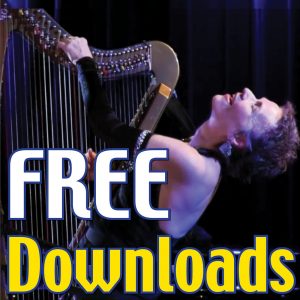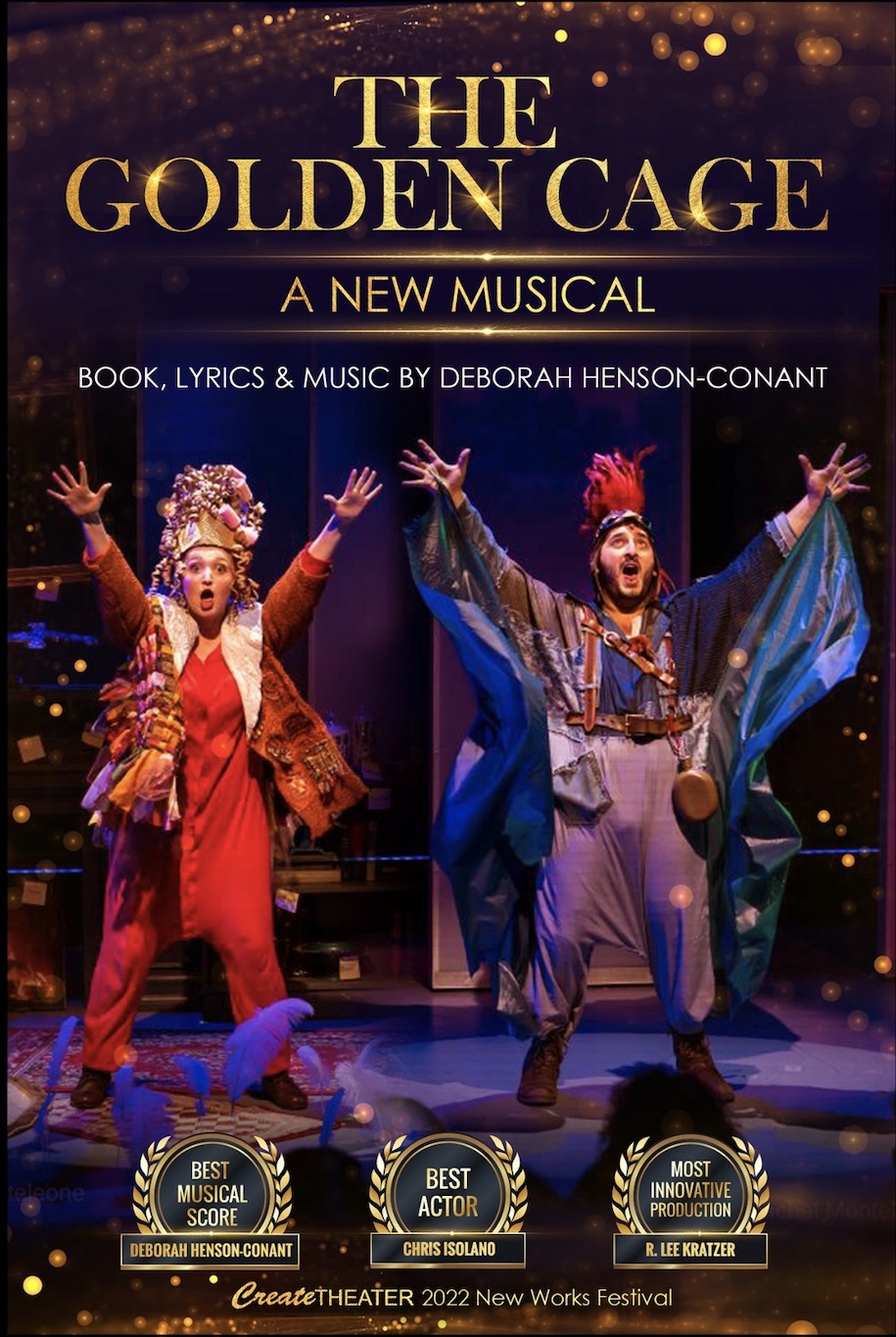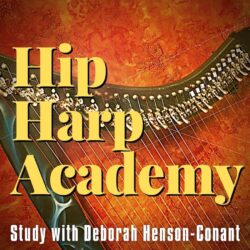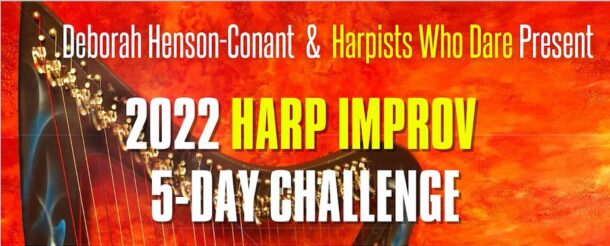
Welcome to Hip Harp Academy Member Spotlight Series: Grounded Expansion Quarter (Part 1 of 3)
For this year’s second quarter, Hip Harp Academy Members poured out their creativity to the next level, putting their creative expression into forms so that they can share it with others. And now, I’m sharing them with you!
Scroll down to see the projects – but first, take a moment to think about the power of people sharing their creative PROCESS instead of a PERFECTED “PRESENTATION.” What you’ll learn from these videos – and the mini-interviews in which they share their process – will be far more inspiring to your creativity than someone sharing a trendy video with five gazillion hits. This is creative process – and in these shares, you get to glimpse into the process of other people like you and HOW they overcame their own blocks to accomplish their next creative goal.
The Hip Harp Academy Members’ Final Beginning Project
How to enjoy these wonderful video shares: Enjoy the creativity and the willingness to share. Think about the fact that each of these videos is a unique creation – none of these musicians are playing written sheet music – they’ve created these arrangements by learning the fundamentals of arrangement and improvisation and putting them into play – literally – in their own creations. And notice how different each video and each project is from the others … and yet they were all taking the exact same class.
This is the power of learning the tools of self-expression and creativity.
“Final-Beginning” is a term we use remind ourselves that these are not meant to be “Final” projects. If we worry about making them ‘FINAL’, we’d never share! Instead, we learn to embody a moment of completion as a new beginning: to acknowledge an accomplishment as something that opens up a new door, a new place to stand in, a new level of confidence – not the FINAL – it’s not the END … but the new BEGINNING.
So think about that as you watch them and read their own account of their personal creative journey in creating each video by clicking the toggle beneath each video – and I encourage you to do that if you really want to be inspired.
Some of the players have played for years, and even decades – some have come to the harp as adults – some even as a retirement gift for themselves. We’re a community connected by a commitment to creative expression. Every week we meet for masterclasses and training, and during the week we practice the new ideas and the willingness to be vulnerable, authentic and self-expressed with our instruments, our voices and ourSELVES.
So be inspired by that commitment, let it infuse your own life – and if you play the harp, come join us at Hip Harp Academy.
Want more confidence, creativity support and freedom from the notes on the page?
If you're looking for more confidence, creativity support and gaining freedom from the notes on the page click the button below and join Hip Harp Academy.
Cherrie Mooney:
Once I came to terms with this style, I moved away from how the tune would come across to others, and just enjoyed it for myself.
.
Cherrie's Insights about this Project
Describe your final project so I know exactly what you’re sending me.
I made a variation of Baroque Flamenco arranged in A harmonic minor. I was intrigued by the mystical feel of this key and chose to experiment, making and combining a number of phrases.
What principles from this course or from chats did you use to develop, perform, and record this project – and how did they play a part in your process?
I developed a structure to ground me and then explored different phase combinations. The most helpful advice was “Hear the beauty “. This allowed me to feel the music as I was playing .
Give a short description of what it took for you to be able to play what you did – both logistically and emotionally.
To be able to play this, I needed to embrace the mystical feeling.
What freedoms and blocks within yourself did you connect with (or struggle with) in the process?
Once I came to terms with this style, I moved away from how the tune would come across to others, and just enjoyed it for myself.
What challenges did you meet while connecting with your own freedom of expression in this project?
It was a challenge playing in this key, as it was very different for me, but I found that I enjoyed the sound.
What other parts of your life were impacted by what you learned in this class, and how?
What music you play, as well as what you do with your life, needs to come from within you, not from what you think is expected of you.
What were your personal “Ahas”?
“Play time” on the harp has become very productive.
Marianne Sandoz:
When you don’t know how to compose music, you can just let the notes you need to hear come to you.
.
Marianne's Insights about this Project
Describe your written materials – if there’s anything in particular you want to say about it to help people know what they’re looking at, add that here.
It’s a piece based on an improv in C Aeolian (intro + ostinato), with 2 pictures and text.
What principles from this course or from chats did you use to develop, perform, and record this project – and how did they play a part in your process?
Improv on a snippet, which appeared after improvising for a while on a starting note (C below middle C) and a mode (Aeolian). I used it as an ostinato.
Give a short description of what it took for you to be able to play what you did – both logistically and emotionally.
Every day I draw one of the 66 sounds of my lever harp as a starting note and a mode (jazz, pentatonic, hijaz, or invented mode) for a short improvisation which I record, then listen to again and write a few lines to summarize what it evokes for me.
What freedoms and blocks within yourself did you connect with (or struggle with) in the process?
It’s a way of connecting with myself. Most of the time it gives me energy, even (or especially?) when I was reluctant to do it.
What challenges did you meet while connecting with your own freedom of expression in this project?
I find it hard to take the time to arrange the improvs so that they’re more unified, but when I do it’s liberating.
What other parts of your life were impacted by what you learned in this class, and how?
For me it’s a kind of daily meditation.
What were your personal “Ahas”?
When you don’t know how to compose music, you can just let the notes you need to hear come to you.
Is there anything else you want people to know when they watch your video?
Credits:
Hasan Kurt
https://www.pexels.com/photo/concrete-pillars-during-night-time-11192539/
Saffron Blaze
https://commons.wikimedia.org/wiki/File:Temple_Apollo_Side_Wide.jpg
Joyce:
I’m getting more comfortable at sharing what I can do.
.
Joyce's Insights about this Project
Describe your final project so I know exactly what you’re sending me.
I did a condensed version of the baroque flamenco on a 22 double string harp. I tried to be as close as I could to the variations from the videos for the easiest version. I’m still a bit stilted but getting more comfortable.
What principles from this course or from chats did you use to develop, perform, and record this project – and how did they play a part in your process?
I used the variations from the videos. I tried to get better at gestures, but still am not as free with them as I would like.
Give a short description of what it took for you to be able to play what you did – both logistically and emotionally.
I worked on the variations and tried to play them with the videos, but then as I was putting them together I’m not sure I was at ease especially when my fingers got stuck on a string in a few places.
What freedoms and blocks within yourself did you connect with (or struggle with) in the process?
I did the doubling for a number of parts for the melody and some of the transitions.
What challenges did you meet while connecting with your own freedom of expression in this project?
I’m working on gestures and rhythm, but mostly to be more at ease with playing.
What other parts of your life were impacted by what you learned in this class, and how?
I’m getting more comfortable at sharing what I can do.
What were your personal “Ahas”?
I take more time to observe how others are playing with their gestures, breathing, and expressions.
Is there anything else you want people to know when they watch your video?
I thought it would be easier to do this on the double string as I was more comfortable with that harp as I have been playing it longer. Though I haven’t been sharing it as much as I should.
Want more confidence, creativity support and freedom from the notes on the page?
If you're looking for more confidence, creativity support and gaining freedom from the notes on the page click the button below and join Hip Harp Academy.
Midyne Spear:
I worried whether it was too sad or schmaltzy. I allowed myself to be more vulnerable and take more risks of exposing how I think & feel.
.
Midyne's Insights about this Project
Describe your final project so I know exactly what you’re sending me.
This is an original song I wrote for my friend & mentor, Tom Prasada-Rao who has been battling cancer for the past 4 or 5 years and recently received word that there’s no longer anything the doctors can do for him.
Attach your homework in PDF or JPEG format here:
Describe your written materials – if there’s anything in particular you want to say about it to help people know what they’re looking at, add that here.
This is a PDF of the lyrics and chords
What principles from this course or from chats did you use to develop, perform, and record this project – and how did they play a part in your process?
I used lever changes & a harmonic minor scale. I also incorporated suggestions from the 1/2 bake for the instrumental section of the song.
Give a short description of what it took for you to be able to play what you did – both logistically and emotionally.
I had to get over the fear of changing levers in the middle of a song, and spent some time coming up with an appropriate chord progression for the instrumental break. The progression uses chords from the song, but not in the order I used during the break. This was something I’ve never done before.
What freedoms and blocks within yourself did you connect with (or struggle with) in the process?
A willingness to be vulnerable in order to share this personal tribute with the world.
What challenges did you meet while connecting with your own freedom of expression in this project?
Worrying whether it was too sad or schmaltzy. Feeling like it might not be as good as other songs written for Tom.
What other parts of your life were impacted by what you learned in this class, and how?
Allowing myself to be more vulnerable and take more risks of exposing how I think & feel. Looking for blueprints that can help me stay grounded.
What were your personal “Ahas”?
The importance of grounding and being present. Changing levers in the middle of a song doesn’t have to trigger a panic attack.
Is there anything else you want people to know when they watch your video?
I just wrote this song on May 18, 2024 and it was inspired by the many photos of friends coming by to say goodbye to Tom and the stories he’s been sharing about what inspired some of his songs.
Cherie Maffey:
I’ve been reluctant to share something that I’ve made up myself. Thinking it may not be good enough. Encouragement from my partner and harp buddy in the Academy has helped.
.
Cherie's Insights about this Project
Describe your final project so I know exactly what you’re sending me.
It’s a greeting video, playing boogie woogie as background music to animal videos from our place. I have made up the tune which reminds me of music my brother played on the piano when I was a kid.
What principles from this course or from chats did you use to develop, perform, and record this project – and how did they play a part in your process?
This is my first attempt at making up my own tune and so I’ve taken ideas from your teaching in the chats. Finding what works and is easiest to do.
Give a short description of what it took for you to be able to play what you did – both logistically and emotionally.
I had to feel the rhythm rather than work it out intellectually. I started very slowly getting the bass rhythm, and then getting the right and left hand to work together.
What freedoms and blocks within yourself did you connect with (or struggle with) in the process?
I’ve been reluctant to share something that I’ve made up myself. Thinking it may not be good enough. Encouragement from my partner and harp buddy in the Academy has helped.
What challenges did you meet while connecting with your own freedom of expression in this project?
Wanting the music to sound like a boogie woogie
as I remembered and how I would dance around the house when my brother played something similar, when I was a kid.
What other parts of your life were impacted by what you learned in this class, and how?
I wanted to share something of my life and the animals that I love. Putting myself out there, and not being afraid of what people might think.
What were your personal “Ahas”?
I can do this! I was so excited that by playing around and exploring patterns I could do some simple things that sounded quite good.
Is there anything else you want people to know when they watch your video?
When I joined the academy I just wanted to learn how to play the harp. I had no idea that I might be able to make up my own music. I have learnt the skills from being in the academy to do this.
Monika:
I struggled with the frustration of being technically unable to play the piece with the expression and tempo I heard and felt it inside myself and to fight the temptation of throwing it away completely because of that. The freedom lay in doing the video and showing it nevertheless.
.
Monika's Insights about this Project
Describe your final project so I know exactly what you’re sending me.
This is a very simple short version of baroque flamenco
What principles from this course or from chats did you use to develop, perform, and record this project – and how did they play a part in your process?
I used the idea of grounding by focusing on the melody and the simple baseline first. Concerning skills I wanted to use strumming because it was completely new for me and seemed a way of expanding
Give a short description of what it took for you to be able to play what you did – both logistically and emotionally.
I needed to choose only simple variations that I was able to play and skip the more difficult ones even those I love most
What freedoms and blocks within yourself did you connect with (or struggle with) in the process?
I struggled with the frustration of being technically unable to play the piece with the expression and tempo I heard and felt it inside myself and to fight the temptation of throwing it away completely because of that. The freedom lay in doing the video and showing it nevertheless.
What challenges did you meet while connecting with your own freedom of expression in this project?
I heard so many great versions of the piece that it was very difficult to see my simple meager version as in anyway acceptable and worthwhile
What other parts of your life were impacted by what you learned in this class, and how?
I realized that I need a big amount of grounding in order to move forward and that I have to allow myself the time for that, even if it goes against my wish to find quick solutions and to have everything ready fast. That concerns many parts of everyday life. I need more discipline to ground (breathe, relax, bodyposture) first.
What were your personal “Ahas”?
see above
Lynne Reardon:
This class had a huge impact on my being confident enough to accept the role of musician for the upcoming public performance of A Midsummer Night’s Dream. Much gratitude!
.
Lynne's Insights about this Project
Describe your final project so I know exactly what you’re sending me.
Original tune for the fairies to sing in A Midsummer Night’s Dream
A. My video description: Fairy Lullaby
B. Here’s what I need coaching on: Ideas for embellishment
C. Other stuff I want you to know about this video: This is a continuation of my work for A Midsummer Night’s Dream; a simple lullaby I composed for the non-singer cast members to learn, using Shakespeare’s lullaby verse. This video will help them as they learn it. Some will sing an octave higher than me. Once they are solid with the melody, I’ll embellish what I do on the harp instead of simply playing the melody.
What principles from this course or from chats did you use to develop, perform, and record this project – and how did they play a part in your process?
The Academy helped me listen to my Muse, improvise, embody characters, and share what I do without being self-conscious that it isn’t “perfect” or feeling “finished”.
Give a short description of what it took for you to be able to play what you did – both logistically and emotionally.
Emotionally I had to accept its simplicity because it’s to be used by non-singers who don’t have much time to learn it.
What freedoms and blocks within yourself did you connect with (or struggle with) in the process?
The fear that it wasn’t “good enough” because it wasn’t complicated.
What challenges did you meet while connecting with your own freedom of expression in this project?
This tune came easily through my Muse, but then I learned during rehearsal that it needed to fit the Shakespearean verse for the lullaby, so I had to do that on the spot with the cast and it actually worked! The biggest challenge was in being brave enough to share it as a possibility for the play.
What other parts of your life were impacted by what you learned in this class, and how?
This class had a huge impact on my being confident enough to accept the role of musician for the upcoming public performance of A Midsummer Night’s Dream. Much gratitude!
What were your personal “Ahas”?
Simple can be good enough. The director and cast liked it.
Is there anything else you want people to know when they watch your video?
This is just one of many tunes and bits of incidental music being created for the play.
Harpists Who Dare!
Are you ready to free yourself from the notes on the page?

PROJECTS & PERFORMANCES:
FOR HARPISTS:
- Join Hip Harp Academy
- Harp Time Live (FREE Weekly Playalong)
- FREE Resources





Join for Freebies, Stories & News
Join to get weekly-ish emails with stories, videos & events like concerts & classes
Yay! You should get my next newsletter within the next 7-10 days. I'm so happy we'll be in touch!
I won't ever share your email address with others - and you can unsubscribe anytime, tho most people say they really enjoy these weeklish emails.